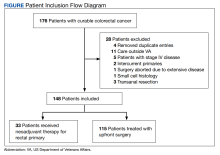Longitudinal Dynamic in Weight Loss Impacts Clinical Outcomes for Veterans Undergoing Curative Surgery for Colorectal Cancer
Background: Definitions of malnutrition imperfectly reflect nutritional status or predict perioperative consequences. We sought to identify predictive nutritional trends by examining the effect of preoperative weight on postoperative outcomes in patients with colorectal cancer (CRC).
Methods: This retrospective review examined 148 patients with CRC treated with curative-intent surgery at the Veterans Affairs Ann Arbor Healthcare System in Michigan from January 1, 2015 to December 31, 2019. We evaluated weight dynamics of patients, starting 1 year before cancer diagnosis until 1 year after surgery. We evaluated the association of these weight dynamics with surgical outcomes. Primary outcomes observed were hospital readmission and length of stay (LOS), chemotherapy completion, and delayed recovery defined as abnormal clinical developments.
Results: There were 115 patients in the colon cancer (CC) cohort and 33 in the rectal cancer (RC) cohort. Low preoperative albumin (< 3.5 g/dL) was present in 25 patients with CC (22%) and 11 patients with RC (33%). Six-month preoperative weight loss of at least 3% occurred in 32 patients with CC (36%). Delayed recovery was observed in 35 patients with CC (30%) and 21 patients with RC (64%). Nutrition consultation rates for the CC and RC groups were 15% and 36%, respectively, before the operation; 95% and 100%, respectively, for postoperative inpatients; and 12% and 73%, respectively, for postoperative outpatients. Six-month preoperative weight loss of ≥ 3% was significantly associated with delayed recovery (P < .001) and 60-day readmissions (P = .015) but not increased LOS or chemotherapy noncompletion.
Conclusions: A ≥ 3% weight loss 6 months preceding curative surgery for CRC was associated with adverse outcomes. An intensive nutrition prehabilitation program initiated at the time of cancer diagnosis is needed and may reduce associated complications.
Methods
This was a retrospective record review of colorectal malignancies treated with curative intent at the Veterans Affairs Ann Arbor Healthcare System (VAAAHS) in Michigan between January 1, 2015, and December 31, 2019. We examined nutritional status, degree of longitudinal weight loss, and subsequent clinical outcomes, including delayed postoperative recovery and delays in chemotherapy in 115 patients with CC and 33 patients with rectal cancer (RC) undergoing curative surgical resection at VAAAHS. To avoid additional confounding effects of advanced cancer, only early-stage, curable disease was included. This study was approved by the VAAAHS Institutional Review Board.
Patients with postoperative follow-up outside of VAAAHS were excluded. Patients were excluded if their surgery had noncurative intent or if they had distant metastatic disease. Data on patient weights, laboratory results, nutrition consultations, postoperative complications, delayed recovery, readmissions, and chemotherapy tolerance were abstracted by patient chart review in the VHA Computerized Patient Record System and Joint Legacy Viewer by 2 researchers.
Delayed recovery was defined as any abnormal clinical development described in inpatient progress notes, outpatient follow-up notes within 60 days, or in hospital discharge summaries. Excluded were psychiatric events without additional medical complications, postoperative bleeding not requiring an invasive intervention, urinary retention, postoperative glycemic control difficulties, cardiac events that happened before postoperative hospital discharge and not requiring readmission, and postoperative alcohol withdrawal. Complications were defined similarly to delayed recovery but excluded isolated prolonged postoperative ileus. LOS was defined in days as time from admission to discharge.
Adjuvant management course was derived from reviewing documentation from medical oncology consultations and progress notes. In patients for whom adjuvant chemotherapy was indicated and prescribed, chemotherapy was considered complete if chemotherapy was started and completed as indicated. Adjuvant chemotherapy was considered incomplete if the patient declined chemotherapy, if chemotherapy was not started when indicated, or if chemotherapy was not completed as indicated. Neoadjuvant therapy data were abstracted from medical and radiation oncology notes.
Recorded data were collected on both weight and BMI. Weights were extracted as follows: Weight 1 year before time of diagnosis, ± 4 months; weight 6 months before diagnosis ± 3 months; weight at time of diagnosis ± 2 weeks; weight at time of surgery ± 2 weeks; weight 30 days postsurgery ± 2 weeks; weight 60 days postsurgery ± 2 weeks; weight 1 year postsurgery ± 4 months. Mean percent change in weight was calculated from recorded weights between each allocated time point. A weight loss of ≥ 3% was found to be clinically relevant and was chosen as the minimal cutoff value when analyzing outcomes associated with weight trends.
Nutrition consultations were abstracted as follows: Preoperative nutrition consultations were defined as occurring between time of cancer diagnosis and surgery in either the inpatient or outpatient setting; inpatient postoperative nutrition consultations occurred during admission for surgery; readmission nutrition consultations occurred on readmission in inpatient setting, if applicable; outpatient postoperative nutrition consultations were defined as occurring up to 2 months postdischarge in the outpatient setting.
Albumin values were extracted as follows: Preoperative albumin levels were defined as up to 4 months prior to diagnosis, and postoperative albumin levels were defined as 2 to 6 months after surgery.







